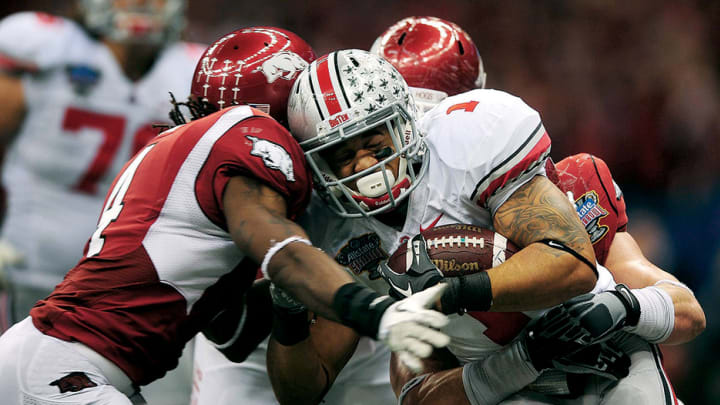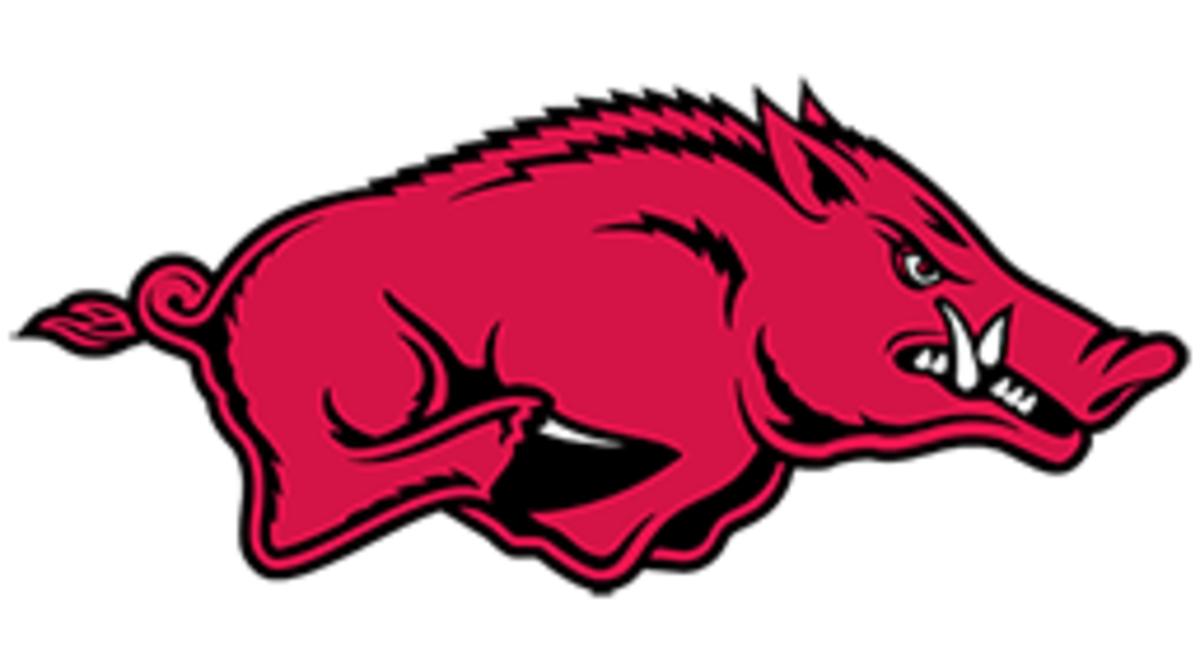With Adjustments, Chip Kelly's Football Proposal Perfect Solution to Problem

FAYETTEVILLE, Ark. – Not a lot comes out of the Pac-12 worth watching, must less worth having a listen, especially all the way out in the SEC footprint. However, recently UCLA head football coach Chip Kelly had a suggestion that should bend the ear of people living in the shadow of each SEC school.
“Notre Dame is an independent in football, but they’re in a conference for everything else,” Kelly told the Los Angeles Times. “Why aren’t we all independent for football? Take the 64 teams in Power 5 and make that one division, take the 64 teams in Group of 5, make that another division. We play for a championship, they play for a championship and no one else gets affected.”
He then went on to explain how travel really isn't an issue in football, but most certainly is in other sports. On all counts he has a valid idea and strong points. However, we all know that when, not if, this happens it will be an opportunity for a reset. College football as we know it relies on television networks and television networks rely on live sporting events. It's the only thing holding up either institution, which is evident by how desperate networks are to sign teams to deals and how desperate universities are to be part of the right deal.
That's why when the final domino falls, leading to exactly what Kelly is describing, there will be a full reset, meaning not every Power Five program makes it through to the other side because there's power and there's power by inherited association.
Television contracts are built upon viewership, not wins or how long someone has desperately clung onto the coattails of fellow conference members. That's why the easiest and most fair way to put together who is in the resulting Power Five and Group of Five is to look at television numbers and cut it off with the Top 64 teams.
That leaves all heavy hitters who do the winning and bring home the proverbial bacon for every one else to keep doing so while allowing opportunity for programs that have quietly built a strong following but might not be perceived as being as successful from a financial potential standpoint as lesser schools because of history and conference affiliation.
There also needs to be a way for teams to earn their way out of the Group of Five. The most simplistic way is to have the Group of Five champion automatically move up each season, while the team with the worst record in the Power Five moves down to take their spot. In the event of a tie, the team with the lowest television viewership takes the demotion.
That last part is probably a bit of relief to Arkansas fans. Because Arkansas is a highly valued Top 20 program in terms of people watching, there is a strong insurance factor for when another interim athletics director hires the next Chad Morris. The odds are pretty much zero that a team with more eyeballs glued to the screen would have a record equally as bad in that case.
So, if this is how it goes down, who does get demoted from the current Group of Five? Let's start with the guys from the SEC shouting at the back of the room. Yes, despite playing in the most powerful conference in college football, Vanderbilt only averaged a reported 37,000 viewers per game in 2021, coming in behind Wyoming at No. 106. To give a little perspective, Arkansas came in at No. 15 that year with 2.03 million per game. It doesn't even seem possible to have that few viewers. The Commodores didn't even show up on the list this year, so Vanderbilt and its FCS football stadium built to house small groups of visiting fans will be the first to fall.
In addition, Duke, Virginia, Houston, Virginia Tech, Arizona State, Colorado and Boston College get bumped, leaving fans of the Big 12 and ACC a little bummed out. Fortunately for the residents of Colorado, there will be a state school making the Power Five, but instead of Deion Sanders and the Buffs, it will be the Rams of Colorado State getting the nod, coming in three spots higher at No. 64.
Also crashing the party will be Army and Navy. The Midshipmen fall just behind BYU and South Carolina at No. 40 as the three highest rated teams without breaking 1 million viewers per week. Army sneaks in a hair above Texas Tech at No. 53 with 681,000 per week while Kansas looms quite a distance above at No. 52 with 732,000.
So now we know who's in, it's time to put together four team pods that will make up each region. A pod plays its pod, plus a pod from its region and then a pod from another region each season. The team with the best overall record in each pod will then play in a 4-team playoff for a regional championship with the winner advancing to the semifinals where all the regional champions will compete for the national title. Rank teams if you want, but it will matter as much as it would to rank teams in the NFL.
So, let's sort this mess out. Then, once everyone has a home, we'll take a look at a couple of sample schedules and what a playoff bracket might look like.

West Region
POD 1
Oregon
Washington
Washington St.
Oregon St
POD 2
Southern Cal
UCLA
California
Stanford
POD 3
Utah
BYU
Colorado St.
Arizona
POD 4
Texas Tech
TCU
Baylor
Texas

Central Region
POD 1
LSU
Texas A&M
Arkansas
Oklahoma St.
POD 2
Nebraska
Kansas St.
Kansas
Oklahoma
POD 3
Missouri
Iowa
Iowa St.
Illinois
POD 4
Ole Miss
Mississippi State
Alabama
Auburn

North Region
POD 1
Ohio State
Cincinnati
Kentucky
Louisville
POD 2
Michigan
Michigan St.
Wisconsin
Minnesota
POD 3
Indiana
Northwestern
Purdue
Notre Dame
POD 4
Penn State
Pittsburgh
Army
Syracuse

East Region
POD 1
Maryland
Navy
West Virginia
Rutgers
POD 2
Tennessee
North Carolina
Wake Forest
NC State
POD 3
Miami
UCF
Florida
Florida St.
POD 4
Georgia
Georgia Tech
Clemson
South Carolina

So, let's start by looking at the schedules of Arkansas and Ohio State. Theoretically, these should play out in a way that has fans and networks begging people to take their money, but will that be true?

Sept. 9 @ Nebraska
Sept. 18 vs. Kansas St
Sept. 23 vs. LSU
Sept. 30 @ Kansas
Oct. 7 vs. Oklahoma
Oct. 14 vs. Ohio State
Oct. 21 @ Texas A&M
Oct. 28 IDLE
Nov. 4 @ Cincinnati
Nov. 11 vs. Kentucky
Nov. 18 @ Louisville
Nov. 25 vs. Oklahoma St.

Sept. 9 @ Pitt
Sept. 18 vs. Oklahoma St.
Sept. 23 vs. LSU
Sept. 30 @ Kentucky
Oct. 7 vs. Army
Oct. 14 @ Arkansas
Oct. 21 IDLE
Oct. 28 vs. Louisville
Nov. 4 @ Texas A&M
Nov. 11 vs. Penn St.
Nov. 18 @ Syracuse
Nov. 25 @ Cincinnati
The Arkansas schedule has a lot of similarities to what the Razorbacks played last season. Games against Kansas, LSU, Texas A&M and Cincinnati have a familiar feel. However, a trip to Nebraska to open the season with an annual closer against Oklahoma State with Ohio State sandwiched in the middle makes for week after week of can't miss games. There's no Western Carolina in the mix.
As for Ohio State, games against Michigan and Wisconsin get replaced with LSU and Texas A&M. However, it should be noted that the Michigan game will still end up being played when we go through the playoffs for this alignment. A trip to Pitt to open the season and a battle for Ohio to close it with Penn State in between isn't that bad of a year. It should be noted that at some point, Alabama, Georgia and Clemson get added to the schedule, so if Buckeye fans aren't overly thrilled with a trip to Syracuse instead of playing Youngstown State or hosting Army instead of Western Kentucky, then just hang on because these schedules change each year.
So, playing this type of schedule might not feel worth it if it leads to an unbalanced playoff where the national championship game ends up played in the first round while a whole half of the bracket fills up with cupcakes gently knocks the frosting off one another in the other. Fortunately, that's not the case with this set-up. A very realistic projection as to how this might play out shows a playoff system begging networks to back the armored trucks full of money right up to the stadium.

Round 1
West Region Semis
Oregon St. vs. USC
Utah vs. Texas
Central Region Semis
LSU vs. Kansas State
Iowa vs. Alabama
North Region Semis
Ohio State vs. Michigan
Notre Dame vs. Pitt
South Coast Region Semis
Maryland vs. Tennessee
Florida St. vs. Georgia

Round 2
West Region Semis
USC vs. Texas
Central Region Semis
LSU vs. Alabama
North Region Semis
Ohio State vs. Notre Dame
South Coast Region Semis
Tennessee vs. Georgia

National Semifinals
USC vs. Alabama
Ohio State vs. Georgia
That's a tremendous playoff slate following what would be a season with blockbuster games to fill the television schedule every week. What's more is the pod system means every now and then teams like Arkansas, Ole Miss and Oklahoma State will make at least the first round of the playoffs. That's big for those type of schools considering right now the door feels closed even in the best of seasons.
What Kelly has put out there is an idea that makes great sense. It would allow the non-football sports to go back to regionally affiliated conferences to ease travel while creating a better, more profitable product. What's more is there will be more interested in the Group of Five games because people will have an interest in seeing who the next team that might move up. It will definitely make the Group of Five national title game a big money maker with so much on the line.
It's a great idea that solves a ton of problems. If this took place in 2024 instead of all these poorly aligned mega-conferences, it would be a huge gain for college football. Also, splitting the television revenue evenly among the top 64 most watched teams with a bonus to the playoff teams would do a lot to stabilize college football. It would certainly be what's best for the sport.

HOGS FEED:
RAZORBACK FANS, MEDIA ALL IN SAME BOAT WITH FOOTBALL RIGHT NOW
HOGS WIDE RECEIVERS COACH KENNY GUITON ON HOW HE'S GETTING GROUP OF NEW FACES IMPROVED
